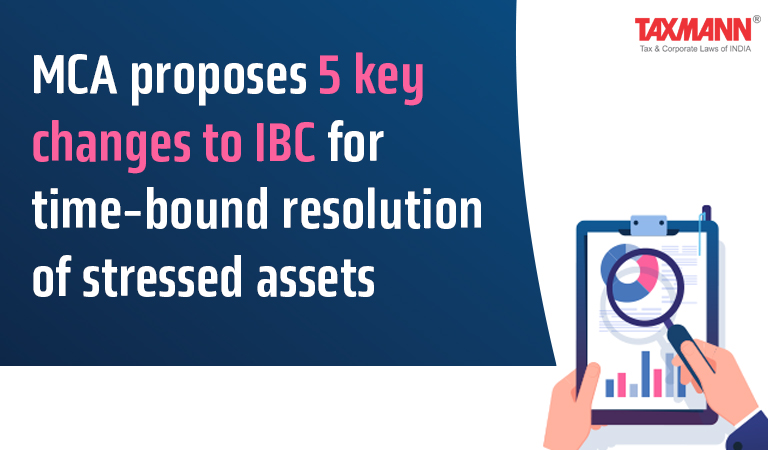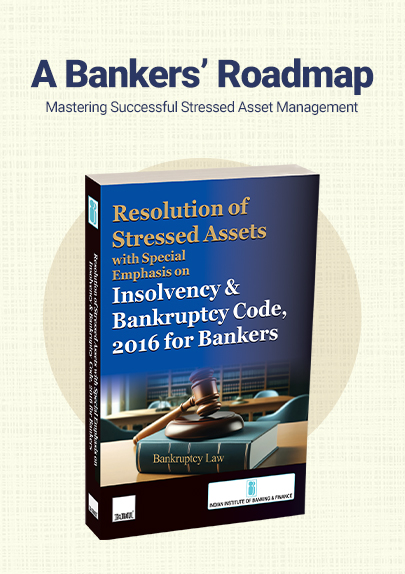MCA proposes 5 key changes to IBC for time-bound resolution of stressed assets
- Blog|News|Company Law|
- 2 Min Read
- By Taxmann
- |
- Last Updated on 27 December, 2021
Public Notice: File No. 30/38/2021-Insolvency; Dated: 23.12.2021
The Ministry of Corporate Affairs (MCA) vide. Public notice File No. 30/38/2021-Insolvency dated: 23.12.2021 has sought public comments on proposed changes to the Corporate Insolvency Framework. Based on the issues raised by Insolvency Law Committee, significant changes have been proposed to enable a swift admission process, streamline provisions about avoidable transactions and wrongful trading and norms relating to the period for approval of resolution plans.
“As the IBC enters the sixth year of its implementation after a year characterised by pandemic-related disruptions, efforts are continued to ensure effective outcomes under the Code,” said MCA. The key changes proposed are discussed hereunder:
1. Financial Creditor to rely on Information Utilities authenticated records to establish default
In order to expedite the admission process and to enable speedily authenticate of financial information, the MCA has proposed that financial creditors as may be required to submit only ‘Information Utilities’ (IU) authenticated records to establish default for the purposes of admission of a Section 7 CIRP application. Consequently, the Adjudicating Authority would only be required to consider IU authenticated records as evidence of default for Section 7 applications filed by such financial creditors as prescribed. This will make the admission process significantly quicker and less cumbersome.
2. Streamlining avoidable transactions and wrongful trading
The Insolvency Law Committee (ILC), earlier in its report recommended amendments to promote cooperation by parties with the resolution professional or liquidator for investigation of avoidable transactions and wrongful trading; allowing creditors to initiate such proceedings; clarifying power of liquidator to file for wrongful trading; etc.
In the light of the above, the MCA proposed that the Code may be amended to provide that the resolution plan should mandatorily specify the manner of undertaking proceedings for avoidance of transactions and wrongful trading if such proceedings are to be continued after approval of the plan. The plan may also be required to specify if the resolution professional would pursue such transactions/ trading or if any other person would do so after the approval of the plan.
Further, the resolution plan may also be required to provide the manner of distribution of expected recoveries from proceedings related to avoidance of transactions and wrongful trading
The MCA felt that the threshold for the look-back period for avoidable transactions may be altered so that a longer net can be cast to effectively capture pre-filing transactions. It is proposed that the look-back period in Sections 43(4), 46(1) and 50(1) may be amended as follows – (i) the threshold for the look-back period may be changed from the date of commencement of CIRP to the date of filing of the application for initiation of CIRP in respect of the corporate debtor that has been admitted; and (ii) the period between the date of filing and the date of commencement of CIRP may additionally be included in the suspect period for such transactions.
Click Here To Read The Complete Document
Disclaimer: The content/information published on the website is only for general information of the user and shall not be construed as legal advice. While the Taxmann has exercised reasonable efforts to ensure the veracity of information/content published, Taxmann shall be under no liability in any manner whatsoever for incorrect information, if any.

Taxmann Publications has a dedicated in-house Research & Editorial Team. This team consists of a team of Chartered Accountants, Company Secretaries, and Lawyers. This team works under the guidance and supervision of editor-in-chief Mr Rakesh Bhargava.
The Research and Editorial Team is responsible for developing reliable and accurate content for the readers. The team follows the six-sigma approach to achieve the benchmark of zero error in its publications and research platforms. The team ensures that the following publication guidelines are thoroughly followed while developing the content:
- The statutory material is obtained only from the authorized and reliable sources
- All the latest developments in the judicial and legislative fields are covered
- Prepare the analytical write-ups on current, controversial, and important issues to help the readers to understand the concept and its implications
- Every content published by Taxmann is complete, accurate and lucid
- All evidence-based statements are supported with proper reference to Section, Circular No., Notification No. or citations
- The golden rules of grammar, style and consistency are thoroughly followed
- Font and size that’s easy to read and remain consistent across all imprint and digital publications are applied






 CA | CS | CMA
CA | CS | CMA


